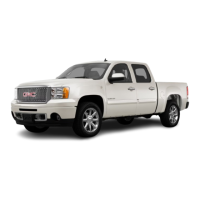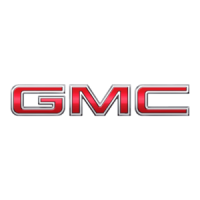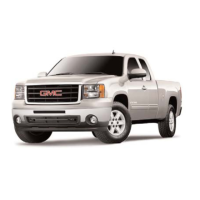Do you have a question about the GMC 2013 GMC Sierra and is the answer not in the manual?
Details the layout and components of the vehicle's instrument panel for different versions.
Provides a brief overview of key features for new drivers, referring to detailed sections.
Covers various vehicle features like radio, satellite radio, portable audio devices, and Bluetooth connectivity.
Discusses vehicle performance aspects and essential maintenance information for optimal operation.
Explains the use of keys, keyless entry systems, and door lock operations.
Details operations for rear doors and the tailgate, including safety features.
Covers vehicle security features like the alarm system and immobilizer operation.
Describes adjustment, folding, heating, and tilt features for exterior mirrors.
Explains the adjustment and operation of manual and automatic dimming rearview mirrors.
Details manual and power window operations, including express-down features.
Covers the operation and features of the sunroof for both extended and crew cab models.
Explains how to adjust head restraints for proper seating positions and safety in a crash.
Covers seat adjustment, center seat features, power seat adjustments, and lumbar support.
Details how to fold rear seats for cargo space and includes safety notices.
Provides essential information on proper safety belt usage, types, and care.
Explains airbag locations, inflation, restraint, and system servicing for safety.
Offers guidance on securing older children, infants, and young children in appropriate restraints.
Details various storage areas in the vehicle, including instrument panel storage, glove box, and console storage.
Covers steering wheel adjustment, steering wheel controls, horn, and windshield wiper/washer operation.
Explains the function and meaning of various warning lights, gauges, and indicators on the instrument cluster.
Details the Driver Information Center (DIC) and its various display messages and customization options.
Lists and explains various vehicle messages, including battery, brake, engine, and fuel system alerts.
Covers exterior lamp controls, headlamp operation, flash-to-pass, DRLs, and hazard warning flashers.
Explains instrument panel illumination, cargo lamps, dome lamps, and reading lamps.
Details entry lighting, exit lighting, and battery load management features for vehicle lighting.
Introduces the infotainment system and guides users to relevant sections for features.
Explains AM/FM radio operation, satellite radio, reception, and antenna types.
Covers CD, CD/DVD, and auxiliary device playback options.
Details the Rear Seat Entertainment (RSE) and Rear Seat Audio (RSA) systems, including headphone use.
Explains Bluetooth connectivity, voice recognition, and phone pairing procedures.
Lists trademarks and license agreements related to the infotainment system components.
Details the operation of climate control systems, including AC and manual/automatic modes.
Explains the function and operation of various air outlets and provides tips for optimal airflow.
Covers essential driving practices like defensive driving, avoiding distraction, and general vehicle control.
Provides guidance on new vehicle break-in, ignition positions, starting the engine, and accessory power usage.
Discusses engine exhaust systems, potential hazards like carbon monoxide, and proper vehicle ventilation.
Explains transmission operation, manual mode, and Tow/Haul mode for optimal performance.
Details four-wheel-drive systems, front axle engagement, and manual transfer case operation.
Covers antilock brake systems, parking brakes, brake assist, and hill start assist features.
Explains the StabiliTrak system, its operation, and related warning lights and messages.
Provides instructions on how to use, set, resume, and disengage the cruise control system.
Details ultrasonic parking assist and rear vision camera systems for parking assistance.
Covers fuel types, recommended fuel, gasoline specifications, and California fuel requirements.
Guides users to dealers for service and parts, emphasizing genuine GM parts.
Provides instructions for performing basic service work and safety checks on the vehicle.
Explains that headlamp aim is preset and may need dealer adjustment after a crash.
Details the proper types of replacement bulbs and where to find procedure information.
Covers electrical system overloads, fuses, and circuit breakers for vehicle protection.
Locates and describes the engine compartment fuse block for accessing fuses.
Locates and describes the instrument panel fuse block for accessing fuses.
Explains the importance of maintenance for vehicle performance, fuel economy, and emissions.
Outlines owner checks, services at fuel stops, monthly checks, and required services based on mileage.
Details services required for extreme conditions, dual wheels, and commercial use.
Covers battery, belts, brakes, and fluids as important aspects of vehicle care.
Lists recommended fluids, lubricants, and parts, including part numbers for replacement items.
Provides a table of common replacement parts like filters and spark plugs with part numbers.
Offers a template for recording vehicle service history and receipts.
Explains how to locate and interpret the Vehicle Identification Number (VIN) and service parts label.
Provides approximate capacities and specifications for various vehicle fluids and systems.
Details engine specifications, VIN codes, and spark plug gaps for different engine models.
Outlines the customer satisfaction procedure for US and Canadian owners, including steps for resolving concerns.
Details the services provided by the Roadside Assistance program for U.S., Canadian, and Mexican owners.
Explains how to report safety defects to US, Canadian, and General Motors authorities.
Discusses the vehicle's event data recorder (EDR) and privacy considerations for recorded data.
Introduces the comprehensive in-vehicle OnStar system and its status indicator lights.
Details the various OnStar services like Emergency, Security, Navigation, Connections, and Diagnostics.
Provides further information on transferring service, reactivation, and how OnStar works.
Details the layout and components of the vehicle's instrument panel for different versions.
Provides a brief overview of key features for new drivers, referring to detailed sections.
Covers various vehicle features like radio, satellite radio, portable audio devices, and Bluetooth connectivity.
Discusses vehicle performance aspects and essential maintenance information for optimal operation.
Explains the use of keys, keyless entry systems, and door lock operations.
Details operations for rear doors and the tailgate, including safety features.
Covers vehicle security features like the alarm system and immobilizer operation.
Describes adjustment, folding, heating, and tilt features for exterior mirrors.
Explains the adjustment and operation of manual and automatic dimming rearview mirrors.
Details manual and power window operations, including express-down features.
Covers the operation and features of the sunroof for both extended and crew cab models.
Explains how to adjust head restraints for proper seating positions and safety in a crash.
Covers seat adjustment, center seat features, power seat adjustments, and lumbar support.
Details how to fold rear seats for cargo space and includes safety notices.
Provides essential information on proper safety belt usage, types, and care.
Explains airbag locations, inflation, restraint, and system servicing for safety.
Offers guidance on securing older children, infants, and young children in appropriate restraints.
Details various storage areas in the vehicle, including instrument panel storage, glove box, and console storage.
Covers steering wheel adjustment, steering wheel controls, horn, and windshield wiper/washer operation.
Explains the function and meaning of various warning lights, gauges, and indicators on the instrument cluster.
Details the Driver Information Center (DIC) and its various display messages and customization options.
Lists and explains various vehicle messages, including battery, brake, engine, and fuel system alerts.
Covers exterior lamp controls, headlamp operation, flash-to-pass, DRLs, and hazard warning flashers.
Explains instrument panel illumination, cargo lamps, dome lamps, and reading lamps.
Details entry lighting, exit lighting, and battery load management features for vehicle lighting.
Introduces the infotainment system and guides users to relevant sections for features.
Explains AM/FM radio operation, satellite radio, reception, and antenna types.
Covers CD, CD/DVD, and auxiliary device playback options.
Details the Rear Seat Entertainment (RSE) and Rear Seat Audio (RSA) systems, including headphone use.
Explains Bluetooth connectivity, voice recognition, and phone pairing procedures.
Lists trademarks and license agreements related to the infotainment system components.
Details the operation of climate control systems, including AC and manual/automatic modes.
Explains the function and operation of various air outlets and provides tips for optimal airflow.
Covers essential driving practices like defensive driving, avoiding distraction, and general vehicle control.
Provides guidance on new vehicle break-in, ignition positions, starting the engine, and accessory power usage.
Discusses engine exhaust systems, potential hazards like carbon monoxide, and proper vehicle ventilation.
Explains transmission operation, manual mode, and Tow/Haul mode for optimal performance.
Details four-wheel-drive systems, front axle engagement, and manual transfer case operation.
Covers antilock brake systems, parking brakes, brake assist, and hill start assist features.
Explains the StabiliTrak system, its operation, and related warning lights and messages.
Provides instructions on how to use, set, resume, and disengage the cruise control system.
Details ultrasonic parking assist and rear vision camera systems for parking assistance.
Covers fuel types, recommended fuel, gasoline specifications, and California fuel requirements.
Guides users to dealers for service and parts, emphasizing genuine GM parts.
Provides instructions for performing basic service work and safety checks on the vehicle.
Explains that headlamp aim is preset and may need dealer adjustment after a crash.
Details the proper types of replacement bulbs and where to find procedure information.
Covers electrical system overloads, fuses, and circuit breakers for vehicle protection.
Locates and describes the engine compartment fuse block for accessing fuses.
Locates and describes the instrument panel fuse block for accessing fuses.
Explains the importance of maintenance for vehicle performance, fuel economy, and emissions.
Outlines owner checks, services at fuel stops, monthly checks, and required services based on mileage.
Details services required for extreme conditions, dual wheels, and commercial use.
Covers battery, belts, brakes, and fluids as important aspects of vehicle care.
Lists recommended fluids, lubricants, and parts, including part numbers for replacement items.
Provides a table of common replacement parts like filters and spark plugs with part numbers.
Offers a template for recording vehicle service history and receipts.
Explains how to locate and interpret the Vehicle Identification Number (VIN) and service parts label.
Provides approximate capacities and specifications for various vehicle fluids and systems.
Details engine specifications, VIN codes, and spark plug gaps for different engine models.
Outlines the customer satisfaction procedure for US and Canadian owners, including steps for resolving concerns.
Details the services provided by the Roadside Assistance program for U.S., Canadian, and Mexican owners.
Explains how to report safety defects to US, Canadian, and General Motors authorities.
Discusses the vehicle's event data recorder (EDR) and privacy considerations for recorded data.
Introduces the comprehensive in-vehicle OnStar system and its status indicator lights.
Details the various OnStar services like Emergency, Security, Navigation, Connections, and Diagnostics.
Provides further information on transferring service, reactivation, and how OnStar works.
| Brand | GMC |
|---|---|
| Model | 2013 GMC Sierra |
| Category | Automobile |
| Language | English |












